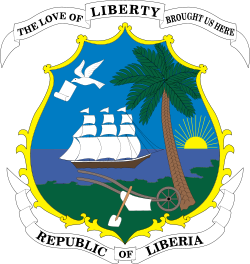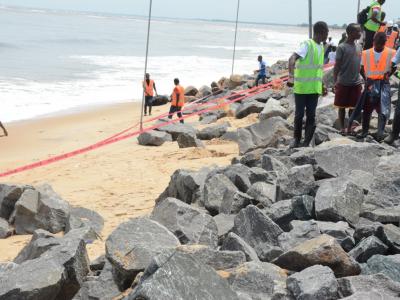Enhancing Resilience of Vulnerable Coastal Areas to Climate Change Risks in Liberia
Enhancing Resilience of Vulnerable Coastal Areas to Climate Change Risks in Liberia
Liberia is highly vulnerable to climate change in coastal areas. The coastal population is poor and all social indicators are very low. Unemployment is high and the gender situation is weak. A large proportion of the coastal community live in temporary and/or poorly constructed housing with little protection from sea or storm surges. A large proportion of these people live on very low lying land, often in unplanned settlements, illegal or extra-legal settlements. For this combination of reasons, the community's capacity to adapt to climate change is very low, and resilience is very limited. In the baseline, climate-change induced sea level rise combined with increasing storms and sea-surges could have catastrophic impacts in terms of destroying livelihoods and lives. Already, key economic sectors of fishing, farming and trade are under risk and the displacement of people is increasing.
LDCF funds will first create a national level enabling environment that is favorable to adaptation in coastal communities across Liberia. This will include the strong support and understanding of national leaders, an empowered inter-sectoral coastal protection unit, clearly established priorities and an operational plan, revised sectoral policies, a cadre of coastal engineers and planners, and adequate tertiary education. Climate related information management will be enhanced, and Liberia will have the capacity to access emerging global adaptation funds.
Source: UNDP Liberia Project Document (April 13, 2010)
Project Overview
Liberia is highly vulnerable to climate change in coastal areas. The coastal population is poor and all social indicators are very low. Unemployment is high and the gender situation is weak. A large proportion of the coastal community live in temporary and/or poorly constructed housing with little protection from sea or storm surges. A large proportion of these people live on very low lying land, often in unplanned settlements, illegal or extra-legal settlements. For this combination of reasons, the community's capacity to adapt to climate change is very low, and resilience is very limited. In the baseline, climate-change induced sea level rise combined with increasing storms and sea-surges could have catastrophic impacts in terms of destroying livelihoods and lives. Already, key economic sectors of fishing, farming and trade are under risk and the displacement of people is increasing.
LDCF funds will first create a national level enabling environment that is favorable to adaptation in coastal communities across Liberia. This will include the strong support and understanding of national leaders, an empowered inter-sectoral coastal protection unit, clearly established priorities and an operational plan, revised sectoral policies, a cadre of coastal engineers and planners, and adequate tertiary education. Climate related information management will be enhanced, and Liberia will have the capacity to access emerging global adaptation funds.
Source: UNDP Liberia Project Document (April 13, 2010)
Project Details
Liberia recently emerged from a lengthy civil war that led to the loss of major institutions and basic infrastructure, including most public administration and most human resources. Recent stabilisation of society, improvements in governance and the support of the international community are helping put Liberia back on a positive development path and it is now considered a country ‘on the move’. Despite this relative peace and stability, numerous barriers exist to tackling the climate change induced threats of coastal erosion and flooding. In turn, damage to coastal habitats and ecosystems could contribute to undermining the recently acquired peace and stability.
At three representative sites, LDCF funds will also demonstrate how low-cost, low-tech, sustainable measures to adapt to climate change can be successfully implemented in coastal areas in the Liberian context. As a result, three sites will be sustainably protected against sea levels storms and surges, and the concerned communities will be sustainably managing coastal ecosystems. Gabion groynes and revetments will be complemented by improved planning, participatory monitoring, improved resources management and community maintenance schemes. These three sites will have served as a school of learning for national and county level experts, agencies and decision-makers. Finally, LDCF Funds will be used to document all successes and disseminate in a targeted manner the lessons learnt.
In each case, LDFC funds are mainstreamed with co-financing activities to yield multiple benefits, including increased resilience to climate change.
Source: UNDP Liberia Project Document (April 13, 2010)
News
Key Results and Outputs
- Outcome 1: National level capacity to plan and respond to climate change in coastal areas is strengthened.
- Output 1.1: Improved data collection, storage, analysis and climate forecasting system.
- Output 1.2: Awareness of senior government people raised.
- Output 1.3: Revised policy in important sectors to account for climate change in coastal areas.
- Output 1.4: Integrated coastal management unit (ICMU), which fully addresses climate change.
- Output 1.5: Climate-change-adapted national integrated coastal area management plans with guidelines on zones, building standards, coastal protection construction needs.
- Output 1.6: Funds (national and international) mobilized to address climate change threats in coastal zones
- Output 1.7: University assisted to establish an undergraduate course on coastal management/engineering with major focus on climate change.
- Outcome 2: Capacity in three coastal counties to plan and respond to climate change is strengthened.
- Output 2.1: Raised awareness of senior county officials, decision-makers and stakeholders.
- Output 2.2: Three county coastal protection units - staffed and equipped.
- Output 2.3: Semi-skilled workers able to prepare and build gabions and revetments etc.
- Output 2.4: A system for monitoring the maintenance of coastal protection measures.
- Output 2.5: County development agendas that fully address climate change prepared and approved.
- Outcome 3: At three sites, sustainable and affordable measures to protect coastal areas against climate change impacts is demonstrated.
- Output 3.1: Lake Piso and coastal communities in Robertsport protected from climate change impacts.
- Output 3.2: Atlantic St., Buchanan and fishing community protected from climate change impacts.
- Output 3.3: Hotel Africa Complex and Blessing St. Community (Kru Town) protected from climate change impacts.
- Outcome 4: Lessons learned and best practices from Outcome 1, Outcome 2 and Outcome 3 are collected and disseminated.
- Output 4.1: The pilot site communities regularly exchange information and experience amongst themselves.
- Output 4.2: A tool for lesson learning - for collecting and storing all the lessons emanating from project.
- Output 4.3: Project lessons learnt shared with local partners and international agencies (including scientific community).
Source: UNDP Liberia Project Document (April 13, 2010)
Reports and Publications
Project Brief / Fact Sheet
PIFs
ProDocs
Monitoring and Evaluation
Project Start:
- Project Inception Workshop: will be held within the first 2 months of project start with those with assigned roles in the project organization structure, UNDP country office and where appropriate/feasible regional technical policy and programme advisors as well as other stakeholders. The Inception Workshop is crucial to building ownership for the project results and to plan the first year annual work plan.
Daily:
- Day to day monitoring of implementation progress: will be the responsibility of the Project Manager, based on the project's Annual Work Plan and its indicators, with overall guidance from the Project Director. The Project Team will inform the UNDP-CO of any delays or difficulties faced during implementation so that the appropriate support or corrective measures can be adopted in a timely and remedial fashion.
Quarterly:
- Project Progress Reports (PPR): quarterly reports will be assembled based on the information recorded and monitored in the UNDP Enhanced Results Based Management Platform. Risk analysis will be logged and regularly updated in ATLAS.
Annually:
- Annual Project Review/Project Implementation Reports (APR/PIR): This key report is prepared to monitor progress made since project start and in particular for the previous reporting period (30 June to 1 July). The APR/PIR combines both UNDP and GEF reporting requirements.
Periodic Monitoring through Site Visits:
- UNDP CO and the UNDP RCU will conduct visits to project sites based on the agreed schedule in the project's Inception Report/Annual Work Plan to assess first hand project progress. Other members of the Project Board may also join these visits. A Field Visit Report/BTOR will be prepared by the CO and UNDP RCU and will be circulated no less than one month after the visit to the project team and Project Board members.
Mid-Term of Project Cycle:
- Mid-Term Evaluation: will determine progress being made toward the achievement of outcomes and will identify course correction if needed. It will focus on the effectiveness, efficiency and timeliness of project implementation; will highlight issues requiring decisions and actions; and will present initial lessons learned about project design, implementation and management. Findings of this review will be incorporated as recommendations for enhanced implementation during the final half of the project’s term.
End of Project:
- Final Evaluation: will take place three months prior to the final Project Board meeting and will be undertaken in accordance with UNDP and GEF guidance. The final evaluation will focus on the delivery of the project’s results as initially planned (and as corrected after the mid-term evaluation, if any such correction took place). The final evaluation will look at impact and sustainability of results, including the contribution to capacity development and the achievement of global environmental benefits/goals. The Terminal Evaluation should also provide recommendations for follow-up activities.
- Project Terminal Report: This comprehensive report will summarize the results achieved (objectives, outcomes, outputs), lessons learned, problems met and areas where results may not have been achieved. It will also lie out recommendations for any further steps that may need to be taken to ensure sustainability and replicability of the project’s results.
Learning and Knowledge Sharing:
- Results from the project will be disseminated within and beyond the project intervention zone through existing information sharing networks and forums.
- The project will identify and participate, as relevant and appropriate, in scientific, policy-based and/or any other networks, which may be of benefit to project implementation though lessons learned. The project will identify, analyze, and share lessons learned that might be beneficial in the design and implementation of similar future projects.
- Finally, there will be a two-way flow of information between this project and other projects of a similar focus.
Source: UNDP Liberia Project Document (April 13, 2010)
Contacts
- The Society for the Conservation of Nature of Liberia and respectively: The Society for the Conservation of Nature of Liberia is constructing energy efficient fish drying ovens in communities around the Lake Piso Multiple Use Reserve
- Alternative Energy is constructing a solar drying facility in Robert Sport, the first ever innovation in Liberia.
- At the Lake Piso Multiple Use Reserve, the project is working with indigenous people grouped under a community-based organization called Lake Piso Conservation Forum. The have been involved in the implementation of the project around the lake.



 Liberia’s President Weah launches new coastal resilience project with support from UNDP
Liberia’s President Weah launches new coastal resilience project with support from UNDP